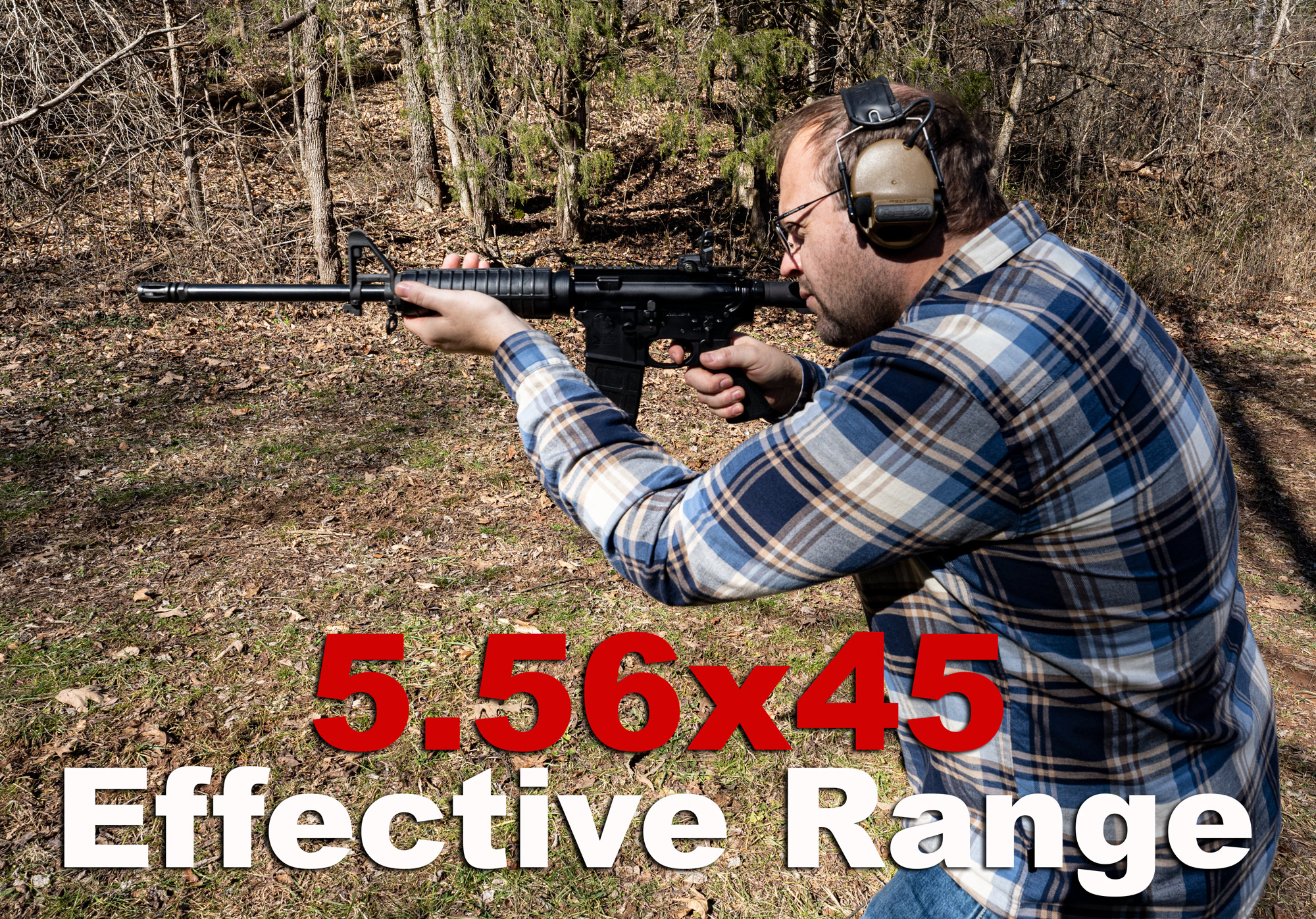A 55 grain .223 bullet can kill a deer if placed accurately. It is, however, at the lower end of suitable calibers for deer hunting.
Hunters often debate the effectiveness of various ammunition for deer hunting, and the. 223 caliber using a 55 grain bullet is a popular topic. Despite being a common round for varmint hunting, the. 223 is also used by some for deer due to its availability and the widespread use of rifles chambered for it.
While its capacity to bring down a deer is subject to precise shot placement and range limitations, the ethics of using a caliber on the lower end of power for such game is frequently discussed among hunting communities. Understanding the importance of shot placement, bullet construction, and state regulations is crucial to ensuring a responsible and humane hunt when considering the. 223 for deer. With advancements in ammunition technology, some 55 grain. 223 loads are designed to maximize tissue damage and ensure a quick, ethical kill. Nonetheless, hunters must consider the capabilities and restrictions of the. 223 caliber to decide if it fits their personal hunting ethics and local legal requirements.
Contents
The Debate On Using 55 Grain .223 For Deer Hunting
Deciding on the right ammunition for deer hunting sparks considerable conversation among hunters. The core of this debate often centers on whether the popular 55 grain .223 caliber round is up to the task. Understanding the capabilities and limitations of this round is crucial for both a successful and responsible hunt.
Ballistic Characteristics Of 55 Grain .223 Rounds
The 55 grain .223 round is known for its speed and flat trajectory, features that contribute to its accuracy at moderate distances. Precise shot placement is possible due to these characteristics:
- High velocity for quicker target reach
- Flat trajectory reduces need for range compensation
- Lightweight design may limit knockdown power
Despite its popularity in small game hunting, its effectiveness for deer hunting remains under scrutiny. Certain factors like shot placement and distance significantly impact its capability to ethically take down a deer.
Legality And Ethical Considerations In Hunting
Before choosing any ammunition, understanding the legal and ethical responsibilities is vital. Regulations on hunting ammunition vary across states, and the .223 is no exception:
- Check local hunting regulations for caliber restrictions
- Consider animal welfare with humane kill potential
- Respect hunting ethics for sustainable practice
Selecting ammunition that quickly and humanely kills deer is an ethical imperative for all hunters. A well-placed shot with the 55 grain .223 can be lethal, yet its performance is heavily debated due to concerns over its stopping power and potential for wounding rather than killing.
In summary, while the 55 grain .223 round has its advocates for deer hunting, its use remains a hotly contested topic. Hunters must weigh the ballistic capabilities of the round with legal and ethical considerations to make an informed decision for their hunting expeditions.
Anatomy Of A Clean Kill
Understanding the Anatomy of a Clean Kill is crucial for ethical deer hunting. A clean kill minimizes the suffering of the animal and ensures a quick harvest. The choice of ammunition is important. Many hunters question whether a 55 grain .223 round can be effective. The answer lies in the intersection of ammunition capabilities and precise shot placement.
Vital Target Areas In Deer
A deer’s anatomy offers specific areas that, when targeted, lead to a quick, humane kill. These vital target areas are:
- The heart: A direct shot will cause rapid blood loss.
- Lungs: Piercing both lungs facilitates a quick collapse.
- Liver: Not as quick as heart or lung shots but can be effective.
Striking these areas with a 55 grain .223 requires precision, as the smaller caliber demands greater accuracy compared to larger rounds.
The Role Of Shot Placement
Shot placement is paramount in ensuring a clean kill with a .223 round. A bullet must reach the deer’s vital organs to ensure a humane kill. The effectiveness of a 55 grain bullet depends on the shooter’s ability to hit these vital areas.
Success with a .223 round entails:
- Steady aim.
- Understanding the bullet’s trajectory.
- Shooting from an appropriate distance.
Shot placement trumps caliber size when aiming for a clean kill. Hence, skilled hunters with a well-placed shot can achieve success, even with a 55 grain .223, by targeting the vital areas highlighted above.
Experiences From Hunters
‘Experiences from Hunters’ delves into the real-world use of the .223 cartridge for deer hunting. While there’s a broad range of opinions on this topic, hunter testimonials offer valuable insight. This section brings forward personal accounts from those who’ve tried their hands with a .223, particularly using 55 grain projectiles, in their pursuit of deer.
Success Stories With .223
Many hunters speak highly of the .223 for deer hunting, especially with a 55 grain bullet. They attribute their success to precise shot placement and the bullet’s effectiveness within appropriate distances. Here are condensed tales of triumph:
- Quick and Humane Kills: Accounts of deer being taken down efficiently, with minimal tracking required.
- Small Caliber Mastery: Stories from seasoned hunters who, with careful aim, have harvested deer successfully.
- Perfect for Youth: Young hunters find the .223 less intimidating, contributing to favorable first experiences.
Challenges And Limitations
While some hunters report success, others caution about the challenges and limitations of using a .223 caliber, particularly the 55 grain version, for deer hunting:
| Challenge | Reason |
|---|---|
| Risk of Wounding | Inadequate energy for clean kills at longer ranges. |
| Limited Shot Placement | Requires highly precise shots that may not always be possible in the field. |
| Weather Conditions | Lighter bullets can be more affected by wind, impacting accuracy. |
Gathered wisdom suggests the importance of evaluating the environment, shot distance, and hunter experience when considering a .223 for deer.
Credit: www.quora.com
Choosing The Right Ammunition
Successful deer hunting with a .223 requires precision in both shot placement and ammunition selection. It’s not just about whether a 55 grain .223 can take down a deer, it’s about making a responsible and ethical choice. The right bullet must ensure a swift and humane kill, adhering to hunting regulations and preserving the integrity of the game meat.
Bullet Types And Terminal Performance
Understanding the impact of a bullet on deer is crucial. Terminal performance refers to how the bullet behaves upon striking the target. The ideal outcome is immediate incapacitation, which is essential for ethical hunting practices.
Expandable bullets achieve this through rapid expansion upon impact, creating a larger wound channel. This expansion leads to significant internal damage, which is often necessary for a swift kill with a small caliber bullet.
| Type of Bullet | Expansion | Penetration |
|---|---|---|
| Soft Point (SP) | Controlled | Deep |
| Bonded | High | Moderate |
| Fragments | Extreme | Shallow |
Penetration depth and the size of the wound channel are factors that hunters should consider. Bullets that do not penetrate deep enough may fail to reach vital organs, while those that penetrate too deeply may exit and waste energy that could have contributed to a quicker kill.
Alternatives To 55 Grain .223
The 55 grain .223 may not always be the best option. Heavier grains and different calibers could offer better performance for deer hunting.
- Heavier .223 Bullets: 62 grain or 77 grain bullets provide increased momentum and may improve terminal ballistics.
- Larger Calibers: Stepping up to a .243 or .270 guarantees more stopping power.
- Premium Rounds: Specialty hunting rounds designed to maximize damage and deliver a clean kill.
When choosing ammunition, respect the game and aim for a quick, humane kill. Different situations might call for different ammunition. Choosing wisely will not only respect the animal but will also ensure the success of your hunt.
Best Practices For Ethical Hunting
Best Practices for Ethical Hunting are crucial to ensure a responsible approach towards wildlife. Ethical hunters respect the game they pursue. They aim for a quick and humane harvest. Using a 55 grain .223 round requires precision and understanding for a clean kill on a deer. As hunters, we must engage in practices that uphold our ethics in the field.
Importance Of Practice And Skill
Becoming a proficient hunter takes time and effort. Regular practice is key. It sharpens shooting skills and improves accuracy. Respect for the animal demands we aim for an immediate and humane kill. Thus, mastery in marksmanship is non-negotiable.
- Visit the range often. Regular target practice helps develop muscle memory.
- Use life-sized targets. They simulate real hunting scenarios.
- Focus on shot placement. Aim for the vital organs to ensure a quick kill.
Knowing Your Equipment’s Capabilities
To make ethical shots, knowing what your rifle can do is crucial. The .223 is a versatile round. Yet, it has limitations especially for deer hunting.
| Range | Effectiveness |
|---|---|
| Short Range <100 yds | High |
| Medium Range 100-200 yds | Moderate |
| Long Range >300 yds | Low |
Understand the distance at which the caliber retains enough power. Insufficient energy for a humane kill at longer distances is a risk. Knowledge of the ballistic performance is essential. Here’s what to always keep in mind:
- Study the ballistic charts for a 55 grain .223 round.
- Know the effective range to maintain stopping power.
- Assess the environmental factors that could affect the bullet trajectory.
Responsible hunters owe it to their quarry to make clean, ethical shots. Ensuring proficiency and knowing the equipment’s capabilities are steps to achieve that.

Credit: www.ammoforsale.com
Expert Opinions And Wildlife Management
Welcome to the heart of our discussion on Expert Opinions and Wildlife Management within the hunting sphere. The choice of ammunition, especially when considering a 55 grain .223 for deer hunting, sparks varied opinions. These hinge on the effectiveness, ethical considerations, and local wildlife regulations. Let’s delve into the insights from conservation professionals and the regulatory stance on such ammunition choices.
Conservation Professional’s Argument
Conservation experts focus on sustainable hunting practices. They weigh the implications of different ammunitions on deer populations and their ecosystems. A 55 grain .223 round, while capable of killing a deer, is often debated.
- Energy Delivery: The round must deliver sufficient energy for a quick, humane kill.
- Shot Placement: It requires precise shot placement, emphasizing the hunter’s skill.
- Caliber Limitations: Some experts argue that higher calibers might be more suitable for ensuring a responsible hunt.
Regulatory Perspective On Ammunition Choices
Game management authorities provide clear guidelines on ammunition choices for hunting. These guidelines ensure the right balance between hunter success and wildlife conservation. With the .223 caliber:
- Legal Restrictions: Some regions restrict the use of .223 for deer, advocating for larger calibers.
- Conservation Goals: Ammunition regulations support long-term deers’ healthy population levels.
- Responsible Hunting: Hunters are encouraged to use ammunition that minimizes suffering for the animals.
In conclusion, while a 55 grain .223 can be lethal for deer, it is a subject that embodies the nuances of ethical hunting and regulatory compliance. The proper consideration of expert opinions and wildlife management directives remains essential for each hunter’s decision-making process.

Credit: www.reddit.com
Frequently Asked Questions On Will A 55 Grain 223 Kill A Deer
Is 55 Grain .223 Adequate For Deer Hunting?
A 55 grain. 223 is considered marginal for deer hunting. While it can be effective, ensuring a precise shot placement is crucial. Many jurisdictions have specific minimum caliber requirements, so always check local hunting regulations before using a. 223 for deer.
What’s The Effective Range Of A 55 Grain .223 For Deer?
The effective range of a 55 grain. 223 for deer is typically around 200 yards, which is the distance within which a well-placed shot can ensure a humane kill. Beyond that, the bullet may not deliver enough force for a clean kill.
Can A .223 With 55 Grain Bullets Ensure A Humane Kill?
A. 223 with 55 grain can ensure a humane kill with accurate shot placement on a deer, particularly when hitting vital organs such as the heart or lungs. However, shot selection and marksmanship are critical factors for this caliber.
What Factors Influence A Successful Deer Hunt With .223/55 Grain?
Successful deer hunting with a. 223/55 grain involves factors like precise shot placement, distance to the target, the deer’s size, and bullet design. A hunter’s skill and the quality of the ammunition also play significant roles.
Conclusion
Understanding the capabilities of a 55 grain. 223 round is crucial for ethical deer hunting. This lightweight projectile can be effective with precise shot placement and at appropriate ranges. As always, hunters should prioritize the animal’s welfare, aiming for a quick, humane kill.
Remember, local regulations and personal marksmanship also play pivotal roles in a successful hunt.


